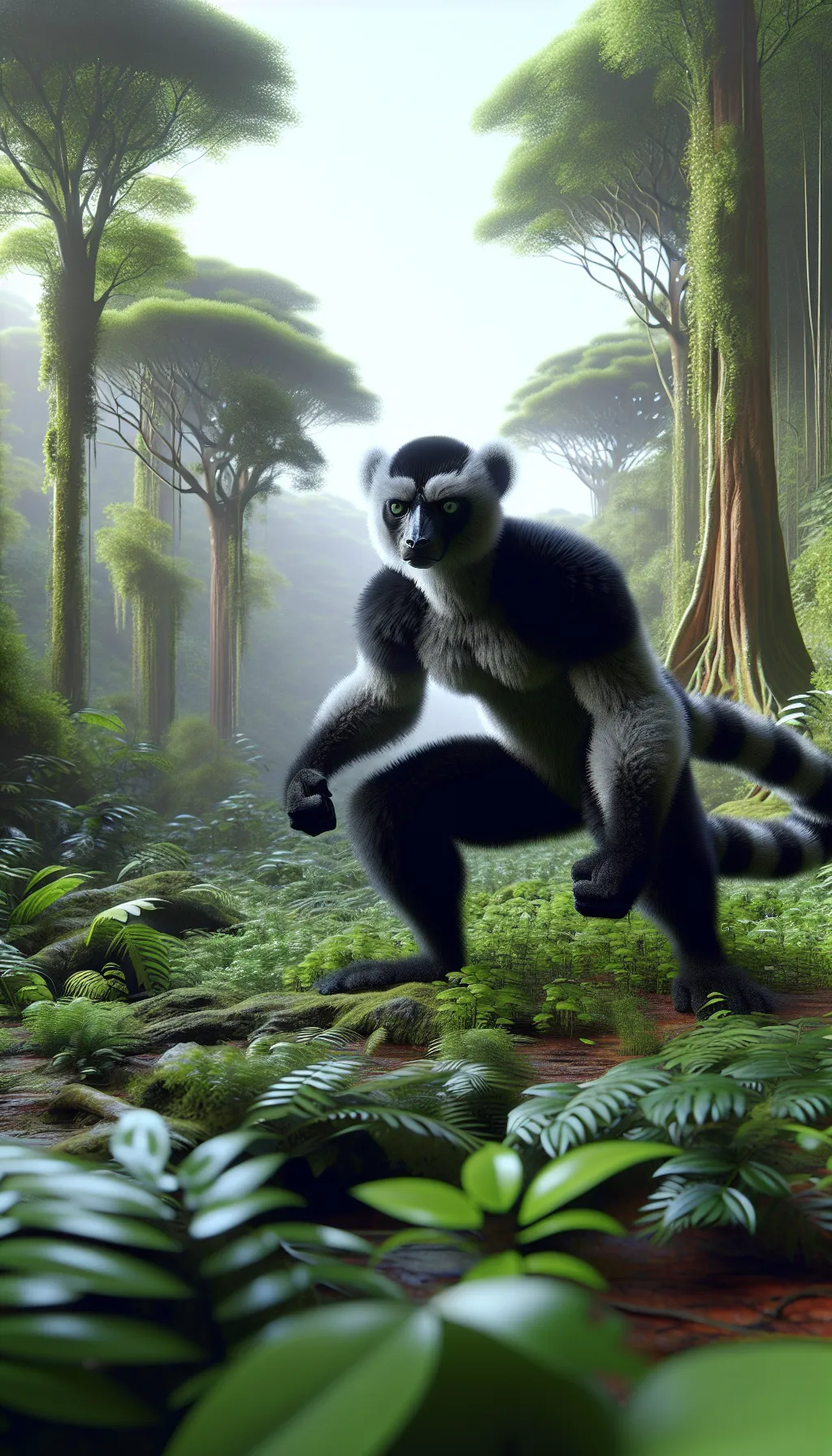The Indri
The Indri, also known as the Babakoto, is a large, black and white lemur endemic to Madagascar. It is the largest lemur species and can reach up to 2.5 feet in length and weigh up to 20 pounds. The Indri has a round head with large, bright yellow eyes and a long snout. It has strong hind legs, which enable it to leap with incredible agility from tree to tree. Its fur is black on the back and limbs, while the head, throat, and chest are a striking white. Known for its distinctive loud song, the Indri is highly vocal and communicates with other indris by emitting eerie, whale-like calls that can be heard as far as 1.2 miles away.

| Indri | |
|---|---|
| Size | Up to 70 cm (27.5 in) |
| Weight | Up to 9 kg (20 lbs) |
| Speed | 20 mph (32 km/h) |
| Key Strength | N/A (Non-aggressive) |
| Biggest Weakness | N/A (Non-aggressive) |
| Scientific Name | Indri indri |
| Family | Indridae |
| Habitat | Rainforests |
| Geography | Madagascar |
| Diet | Herbivorous |
| Lifespan | 18 years - 20 years |

The Indri
The Indri, also known as the Babakoto, is a large, black and white lemur endemic to Madagascar. It is the largest lemur species and can reach up to 2.5 feet in length and weigh up to 20 pounds. The Indri has a round head with large, bright yellow eyes and a long snout. It has strong hind legs, which enable it to leap with incredible agility from tree to tree. Its fur is black on the back and limbs, while the head, throat, and chest are a striking white. Known for its distinctive loud song, the Indri is highly vocal and communicates with other indris by emitting eerie, whale-like calls that can be heard as far as 1.2 miles away.
Fun Fact: The Indri is unique among lemurs as it has a specialized toothcomb on its lower jaw, similar to other primates, which it uses to groom its long, silky fur.
| Indri | |
|---|---|
| Size | Up to 70 cm (27.5 in) |
| Weight | Up to 9 kg (20 lbs) |
| Speed | 20 mph (32 km/h) |
| Key Strength | N/A (Non-aggressive) |
| Biggest Weakness | N/A (Non-aggressive) |
| Scientific Name | Indri indri |
| Family | Indridae |
| Habitat | Rainforests |
| Geography | Madagascar |
| Diet | Herbivorous |
| Lifespan | 18 years - 20 years |
Indri Matchups
We use AI to simulate matchups between the Indri and other animals. Our simulation considers size, strength, and natural predatory behaviors to determine the most likely outcome.

Can't find the Matchup you want?
Create Your Own MatchupIndri: Diet, Predators, Aggression, and Defensive Behaviors
What do Indris eat?
Indris are herbivores, primarily feeding on leaves, fruits, flowers, and seeds. Their diet consists mainly of a variety of plant species found in their habitat, such as young leaves, buds, and shoots. They are known to be selective eaters, preferring certain types of plants over others based on seasonality and availability.
Do Indris have any predators?
Indris do not have many natural predators due to their large size and arboreal lifestyle. However, their primary predators include the fossa, a carnivorous mammal native to Madagascar. Since Indris spend most of their time in the treetops, they are relatively safe from ground-dwelling predators.
Are Indris aggressive?
Indris are generally peaceful and non-aggressive animals. They live in small family groups and communicate through loud vocalizations rather than physical aggression. However, they may exhibit territorial behavior towards other groups of Indris or when threatened by predators.
Do Indris fight?
Indris typically avoid physical confrontations and prefer to resolve conflicts through vocalizations and displays of dominance. In rare cases of aggression or territorial disputes, they may engage in minor physical altercations such as pushing, shoving, or biting. These fights are usually not severe and are used more as a last resort.
How do Indris defend themselves?
Indris have several ways to defend themselves against predators or threats. Their loud and distinctive vocalizations serve as warnings to potential predators and help to deter them. Additionally, they can move quickly through the trees to escape danger and may use their powerful hind legs to kick or push away aggressors if necessary.
What is the biggest weakness of Indris in a fight?
Despite their agility and strong hind legs, the biggest weakness of Indris in a fight is their lack of physical weaponry or defensive capabilities. They do not have sharp claws, teeth, or other adaptations for combat, making them vulnerable in direct confrontations with predators or other threats. As a result, they rely more on their vocalizations and agility to avoid conflicts whenever possible.
Fun Fact: Unlike other lemurs, the Indri does not have a tail, making it more similar in appearance to other primates, such as monkeys and apes.
Fun Fact: Indris live in small family groups, consisting of a breeding pair and their offspring. These groups defend their territories by marking tree trunks with scent glands located on their throats to deter other groups from intruding.











